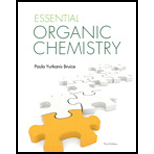
Concept explainers
(a)
Interpretation:
Movement of electrons should be indicated using curved arrows for the given reaction.
Concept introduction:
Mechanism of the reaction is the step-by-step description of the process by which reactants are changed into products.
Curved arrows show the bonds that are formed and the bonds that are broken in a reaction.
Curved arrows used to understand a reaction mechanism.
Curved arrows are drawn to show how the electrons move as new covalent bonds are formed existing covalent bonds are broken.
Each arrow represents the simultaneous movement of two electrons from a nucleophile towards an electrophile.
The tail of the arrow is positioned where the electrons are in the reactant; the tail always starts at a lone pair of electron or at a bond.
The head of the arrow points to where these same electrons end up in the product; the arrow always points at an atom or a bond.
(b)
Interpretation:
Movement of electrons should be indicated using curved arrows for the given reaction.
Concept introduction:
Mechanism of the reaction is the step-by-step description of the process by which reactants are changed into products.
Curved arrows show the bonds that are formed and the bonds that are broken in a reaction.
Curved arrows used to understand a reaction mechanism.
Curved arrows are drawn to show how the electrons move as new covalent bonds are formed existing covalent bonds are broken.
Each arrow represents the simultaneous movement of two electrons from a nucleophile towards an electrophile.
The tail of the arrow is positioned where the electrons are in the reactant; the tail always starts at a lone pair of electron or at a bond.
The head of the arrow points to where these same electrons end up in the product; the arrow always points at an atom or a bond.
(c)
Interpretation:
Movement of electrons should be indicated using curved arrows for the given reaction.
Concept introduction:
Mechanism of the reaction is the step-by-step description of the process by which reactants are changed into products.
Curved arrows show the bonds that are formed and the bonds that are broken in a reaction.
Curved arrows used to understand a reaction mechanism.
Curved arrows are drawn to show how the electrons move as new covalent bonds are formed existing covalent bonds are broken.
Each arrow represents the simultaneous movement of two electrons from a nucleophile towards an electrophile.
The tail of the arrow is positioned where the electrons are in the reactant; the tail always starts at a lone pair of electron or at a bond.
The head of the arrow points to where these same electrons end up in the product; the arrow always points at an atom or a bond.
(d)
Interpretation:
Movement of electrons should be indicated using curved arrows for the given reaction.
Concept introduction:
Mechanism of the reaction is the step-by-step description of the process by which reactants are changed into products.
Curved arrows show the bonds that are formed and the bonds that are broken in a reaction.
Curved arrows used to understand a reaction mechanism.
Curved arrows are drawn to show how the electrons move as new covalent bonds are formed existing covalent bonds are broken.
Each arrow represents the simultaneous movement of two electrons from a nucleophile towards an electrophile.
The tail of the arrow is positioned where the electrons are in the reactant; the tail always starts at a lone pair of electron or at a bond.
The head of the arrow points to where these same electrons end up in the product; the arrow always points at an atom or a bond.
Want to see the full answer?
Check out a sample textbook solution
Chapter 5 Solutions
Pearson eText for Essential Organic Chemistry -- Instant Access (Pearson+)
 Organic Chemistry: A Guided InquiryChemistryISBN:9780618974122Author:Andrei StraumanisPublisher:Cengage Learning
Organic Chemistry: A Guided InquiryChemistryISBN:9780618974122Author:Andrei StraumanisPublisher:Cengage Learning Chemistry: The Molecular ScienceChemistryISBN:9781285199047Author:John W. Moore, Conrad L. StanitskiPublisher:Cengage Learning
Chemistry: The Molecular ScienceChemistryISBN:9781285199047Author:John W. Moore, Conrad L. StanitskiPublisher:Cengage Learning


